As someone who’s backpacked across Costa Rica for six months, I wanted to let you know that Costa Rica has it all. A low cost of living, vivid landscapes everywhere you look, beautiful weather, and even safety if you keep your wits about you. Furthermore f you’re from the EU, Canada or the United States and are looking to leave, you’ll also enjoy an exchange rate tilted in your favour here. Take that inflation!
While all of these amenities sound nice, they fail to answer the main question of determining where you should live in Costa Rica.
When looking at the map of this lovely nation, it can feel like choosing a place to settle is like taking a spin on the roulette wheel. For example, some expats may want to be close to the cities, but not fully inside the hustle and bustle of San Jose.

Or to the contrary, some may want to settle in a beach town, but do not enjoy the thought of a 2 hour off-road excursion to get there. Not to worry, with my experience living in Costa Rica for half a year, I can give you my first hand experience of each region and town and help you decide where in Costa Rica works best for your lifestyle and goals.
Find What You’re Looking For Before Deciding Where You Should Live In Costa Rica
Before heading to any Costa Rican city it’s critical to map out your travel plans and understand your personal preferences. This is so you can stay in the cities and towns you’ll enjoy the most and maybe even bump into like-minded expats on your journey. Please note, it will be hard to find a place you won’t like in Costa Rica, so don’t worry too much. Eitherway, I’m assuming you’re looking to stay in Costa Rica for the longer term if you’re reading this; however I have included cities and places for all lengths of stay.
Furthermore, I’ve also determined each city by other factors such as, airline availability, the beach quality, accommodation cost, and accessibility by transportation which is important for people coming here as often the roads can be lower quality than back home. Consider the cost of living in a jungle paradise. Anywho I’m positive these notes from my stay will help you find a hidden gem in where you should live in Costa Rica.
Costa Rica’s Geography Will Help You Find Your Favorite Spot
I want you to visualize with me for a moment the country of Costa Rica. The country is covered in mountainous regions from the north west to the south east with a more temperate, central valley in the middle. On each side of these ranges there are two climatic zones. On the west you’ll experience a tropical savanna climate, and on the east, a hot and sticky equatorial climate.
Keep this in mind while deciding where you’d like to live because most of the population, airports, and infrastructure is found on the west side. However, some of the most beautiful sights and resorts are hidden in the east. Furthermore, you’ll find nicer, sunnier weather on the northern west coast and they also have a shorter wet season too. We’ll explain more about that later. Either way, if you’re a climate junky like myself, there’s a climate for everyone in Costa Rica’s many geographic regions.
Before you settle in some random town and live ‘La Vida Loca’ in Costa Rica, its first essential to take a look at the separate regions that make up the country.
You can split this country up into 7 regions. These regions are closley related to the provinces in Costa Rica as seen on this map.
Let me tell you about all of them.
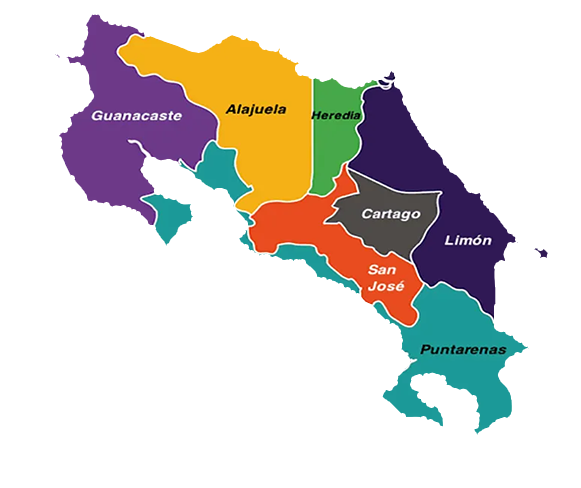
The Caribbean Coast:
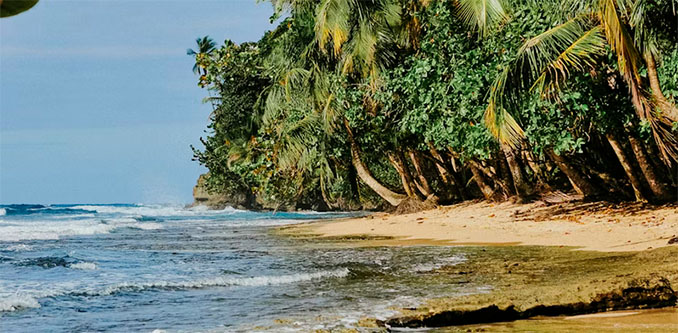
The Caribbean coast of Costa Rica is a laid back and relaxing zone of leisure. As you traverse it you’ll see its magnificent resorts, sandy beaches and beautiful snorkeling spots. The Carribean coast is also home to the Green Sea Turtle which draws many tourists and ecological experts from around the world to help them hatch. It’s generally less populated and more laid back than the west coast. However outside of the touristic spots there’s not many largely populated cities making it not the best place if your expatting. However for vacationers it’s great!
The Central Valley:
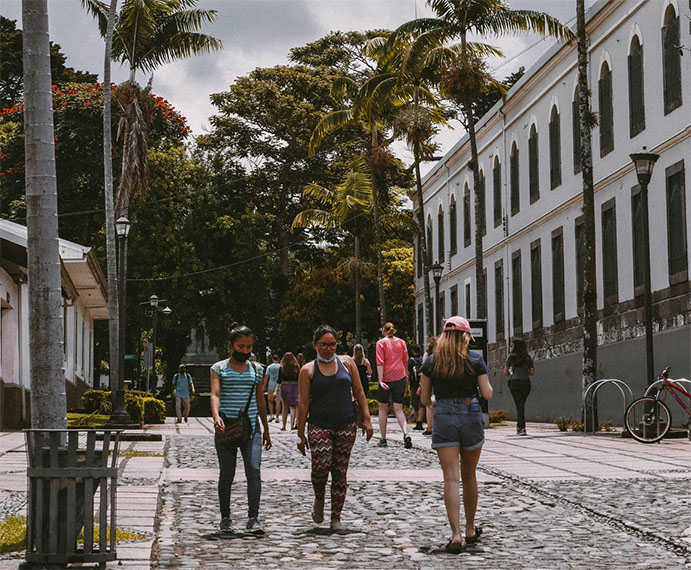
Welcome to the Costa Rican Central Valley. This area houses 2/3rds of Costa Rica’s population and is the top spot to be if you’re looking to make local friends and build your network. The Central Valley contains San Jose, the city’s capital and the majority of Cost Rican industry lies here.
Geographically speaking it’s nestled in the plains and surrounded by beautiful mountains all around. The climate is quite nice as well, but because it’s higher in elevation, it can reach nightly lows of under 10 degrees celsius in the winter. Eitherway it can be a refreshing break from the coastal and low lying regions of the country.
Guanacaste Region:
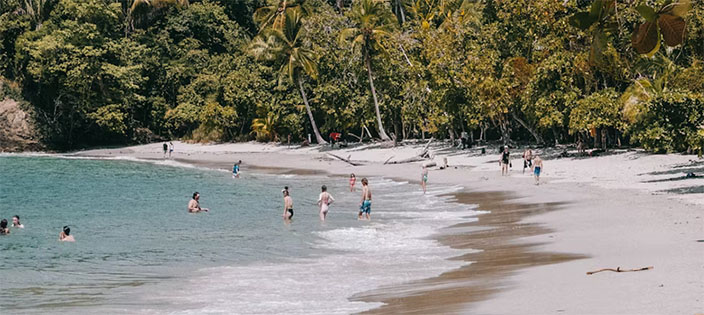
The Guanacaste region is located in the north-western corner of Costa Rica. Guanacaste has arguably the best year-round weather in the country. It is also the driest and warmest part of Costa Rica, the best region for beach bums, surfers, and people like myself who have SAD (Seasonal Affective Disorder). Day to day, you’ll enjoy temperatures in the mid-to-late 80s for much of the year with lower humidity than most of the country.
That doesn’t mean it won’t rain here! There still is a rainy season from May to November, but even then, that’s a small timeframe compared to most of the Costa Rican countryside. If you break it down daily, when you live in the Guanacaste region you’ll experience hot and sun most of the morning and mid day with stronger showers rolling into the afternoon.
The Nicoya Peninsula
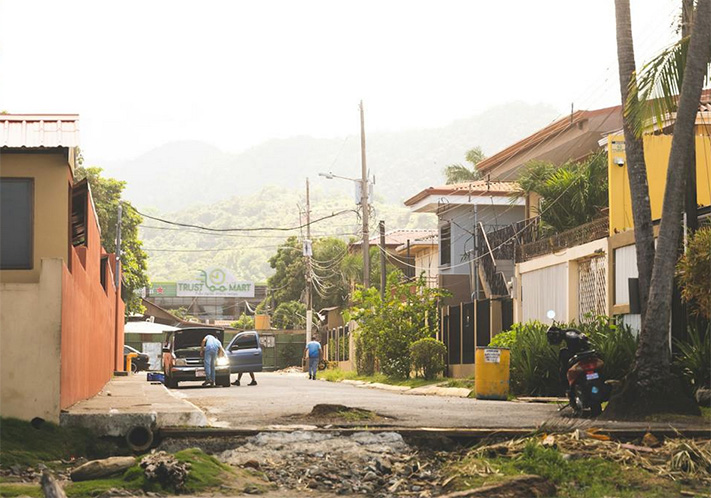
Fun Fact: The Nicoya Peninsula is home to one of the world’s five “Blue Zones” where people live exceptionally long lives. This lovely region, straddling parts of Guanacaste and Puntarenas Provinces, offers an interesting blend of dry savanna and tropical biomes so you’ll want to pack your towel and your rain gear if planning a stay here. Its unique landscape is perfect for beach days in the morning and dense rainforest nature treks in the afternoon. However, be aware that the semi-remoteness of the area can mean higher costs for food and accommodation.
The Nicoya Peninsula appeals particularly to those who love nature and tranquility. While it’s less populated, it’s ideal for adventurers looking to dive into authentic Costa Rican culture. Here you can explore quaint villages, hidden coves, and mysterious islands along its picturesque coast. It’s also quite safe. If you’re looking for real estate deals here, you should move quickly. The peninsula is growing in popularity among expats, due to its untouched location, it’s semi-closeness to the airports, and the serene lifestyle it offers.
The Central Pacific
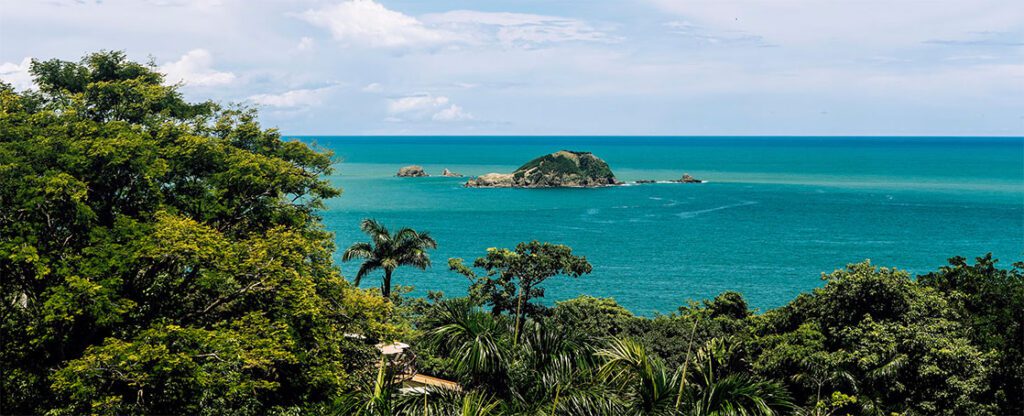
Moving southward from the Nicoya Peninsula, you will reach the Central Pacific region of Costa Rica. This lovely area encompasses growing surfing cities and expat getaways such as Jaco and Punta Arenas. These small towns have been growing bigger by the day due to the amenities they offer and the proximity to the capital. The Central Pacific is also amazing for wildlife lovers and people looking for luxurious escapes. Plop down your chair on the beach and you’ll see the exotic birds, sloths, and insects buzzing about. Or head into some exclusive airBnBs by the seaside to work on your next online empire.
Northern Lowlands:

The northern lowlands are a region in the mountainous north-central sector of the country. They encompass various biomes including mountain ranges, lowlands, swamps, cloud forests and even rushing rivers. While you can get into this area, I advise you only to go for touristic purposes and not for long stays. Let me explain: Just by getting to Caño Negro I had to fly into Quebrada Azul, and take a 4×4 vehicle an hour deeper into the jungle. But, it was worth it for the abundant wildlife watching and unique natural experiences.
The South Pacific:
Now, if you’re looking to see even more pristine wilderness, you’ll want to head into Costa Rica’s untouched and least visited region: The South Pacific coast. Here in the South Pacific you’ll find biodiversity at its greatest. Honestly it’s like walking into a David Attenbourgh – Planet Earth Documentary.
Nature lovers will never want to leave it’s lush landscapes. The South Pacific region in Costa Rica includes untouched beaches, exotic flora and fauna, and an average water temperature 24 – 28 degrees celsius. However, when coming here it is somewhat difficult to get to, you’ll have to take a small passenger plane in and out. Sadly while it’s one of the most beautiful places, it can be hard to find wifi access unless you have a local cellular plan. Furthermore, it’s sparsely populated making it tough for extroverted travelers to see people.
Where You Should Live In Costa Rica: The Best Places for Expats
Jaco: Costa Rica’s Lively Beach Town
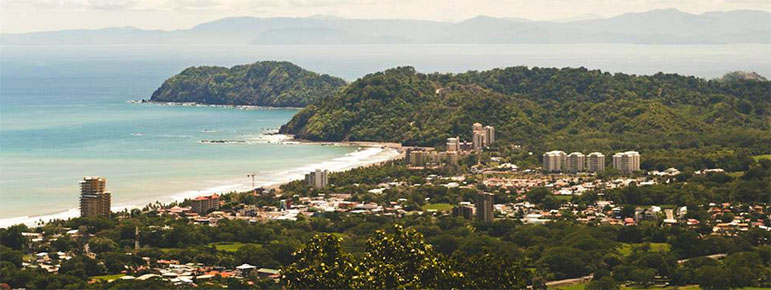
From the moment I set foot in Jaco, I knew I had found something special. As a vibrant coastal city famed for its surf spots and electrifying nightlife, Jaco presents a striking contrast to the quieter, more reserved beach towns of Costa Rica. For someone like me, hailing from the bustling streets of Toronto, Jaco felt just like home but with an exotic twist.
Why Jaco Stands Out for Expats
Jaco’s allure is not just its stunning beaches or the pulsating nightlife; it’s the seamless blend of local charm with international amenities that makes everyday life here both comfortable and exciting. This town is fully equipped to cater to the needs of expats from North America, boasting everything from international cuisine and shopping centers to reliable healthcare—ensuring a smooth transition into your new coastal life.
Living in Jaco means embracing adventure right at your doorstep. Whether it’s catching the early morning waves renowned among surfers worldwide or exploring the rich marine biodiversity through snorkeling and scuba diving, there’s never a dull moment. The local community is particularly welcoming to newcomers, with numerous social clubs and expat groups that make it easy to find friends and network.
Navigating Life in Jaco
Jaco is incredibly accessible, which was a huge draw for me. Situated just an hour and a half from San José and its international airport, travel to and from the United States and Canada is straightforward, making those visits home or welcoming family and friends a breeze. The local transportation, including buses and taxis, is reliable, but I found everything I needed within walking or cycling distance.
Cost of Living: A Pleasant Surprise
One of the most appealing aspects of Jaco for me was the cost of living. Compared to back home, I found that my dollars stretched further, allowing me to enjoy a higher quality of life. Accommodations are varied, offering something for every budget. I rented a quaint apartment just a few blocks from the beach that was both affordable and well-appointed. For those considering a more permanent move, there are plenty of real estate options that offer good value for money.
Community and Social Life
The expat community in Jaco is active and inclusive. Regular meet-ups, cultural festivals, and community events provide ample opportunities to mingle and immerse oneself in the rich Costa Rican culture. It’s easy to see why many expats, including myself, feel drawn to this vibrant town.
Advice for Future Expats Coming to Jaco:
My week in Jaco flew by in a blur of sunsets, sand, and social outings. It gave me a taste of what life could be like living here, surrounded by natural beauty and supported by a community of like-minded adventurers and expats. Jaco offers a perfect mix of relaxation and excitement, making it ideal for those looking to relocate from busier urban centers in North America.
For anyone from the USA or Canada considering a move to Costa Rica, Jaco should definitely be on your radar. Whether you’re retiring, looking for an investment opportunity, or simply in need of a change of scenery, Jaco provides an excellent balance of adventure, community, and comfort. Start with a short visit, test your surroundings, build your network, and like me, you might just find yourself plotting a permanent move to this lively Costa Rican haven. For more information on leaving your home country, check out our guides.

Explore Your Opportunities Abroad
Use the Canadian Exit Guide to see how you can leave Canada to find better opportunities abroad.
Playas Del Coco
Nestled in the stunning Gulf of Papagayo, Playas del Coco, also known just as El Coco or even ‘Coco’, is a vibrant beach town known for its scenery and family-friendly vibe. Located a small 30 minutes from the Daniel Oduber Quiros International Airport (Liberia Airport), Coco offers easy access to a plethora of activities that make it a top destination for both local families and international tourists.
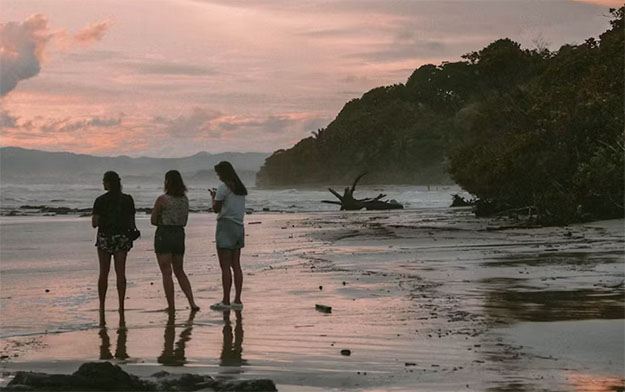
Coco offers a blend of laid-back beach life and modern conveniences. The town is compact enough to explore on foot, and it boasts a variety of international restaurants and quaint cafes, making it ideal for those seeking a relaxed, yet sociable atmosphere. The close-knit expat community here often gathers for beach cleanups, social events, and outdoor activities, providing a warm welcome to newcomers.
Why Expats Should Settle in Playas del Coco
Playas del Coco provides a perfect mix of relaxation and adventure for those who want the best of both worlds. The town’s black sand beach stretches over three kilometers and is met by lush hills and dramatic cliffs, creating a postcard setting for your Costa Rican lifestyle. Known for its gentle waves nearly year-round, the beach is ideal for swimming, bathing, and even skim boarding when the water picks up.
Adventure seekers will find plenty to do with nearby attractions including surfing, scuba diving, and snorkeling. The local marine life is abundant, with stingrays, whale sharks and coral reefs waiting for you down below. I suggest scuba diving in and around the three visible islands from the main beach for the best wildlife viewing.
Life in Coco revolves around its breathtaking sunsets, which paint the sky with hues of orange and pink. Formerly a humble fishing village, the town has grown into a bustling tourist hub without losing its charming character. The main street, Route 151, is dotted with a variety of bars, restaurants, and shops, leading directly to the main park and beach entrance. The local neighborhoods, just outside the downtown area, maintain a welcoming and intimate atmosphere.
High Accessibility by Airline or Car
Playas del Coco is exceptionally accessible, located just 17 miles (27 kilometers) from the Guanacaste Airport, which services numerous international and domestic flights. Major airlines including United, Delta, and Southwest offer direct flights from several U.S. cities, making Playas del Coco a convenient destination for North American travelers. For those coming from within Costa Rica or from the capital, San Jose, the town is a scenic 4.5-hour drive across 151 miles (243 kilometers) of Costa Rica’s lush landscapes, with well-maintained roads and clear signage.
Beach Score
Playas del Coco boasts a high beach score due to its vast amenities, safety, and cleanliness. The beach’s dark volcanic sand, combined with its scenic beauty and the availability of lifeguards during peak seasons, ensures a safe and enjoyable experience. The beach also features showers, picnic areas, and plenty of spots for beach sports, making it perfect for families and solo travelers alike.
Costs in Cocos
Accommodation in Playas del Coco ranges from budget-friendly hostels to luxurious beachfront resorts, catering to all types of travelers. On average, a night in a standard hotel room can cost anywhere from $50 to $150, depending on the season and proximity to the beach. For those seeking longer stays, rental apartments and homes are available, typically ranging from $800 to $2000 per month, offering a more immersive experience into the local lifestyle.
Planning Your Visit to Cocos
Whether you’re looking to relax on the beach, explore the ocean, or simply soak in the local culture, Playas del Coco offers a comprehensive guide to ensure your visit is memorable. Find out the best places to stay, dine, and explore in our detailed visitor’s guide to Playas del Coco—your gateway to a dream vacation in Costa Rica.
Quepos – Low Key Community Connected to Nature

Quepos is a small town that serves as the gateway to Manuel Antonio National Park, one of Costa Rica’s most famous conservation areas. This town is a hotspot for expats who are drawn to its natural beauty and wildlife. Quepos provides a slower pace of life away from the hustle and bustle. The local community is active in environmental activities, making it a great place for those who are environmentally active. Additionally, its weekly farmers’ market offers the freshest produce and local crafts, enhancing its appeal among those who prefer a quieter, more sustainable lifestyle.
Nestled between the lush rainforests of the Central Pacific and the sparkling waters of the Pacific Ocean, Quepos is a vibrant town renowned for its natural beauty and proximity to the world-famous Manuel Antonio National Park. Just a short drive from the San José and well-connected by local and international flights landing at Quepos Managua Airport, this town offers an ideal mix of accessibility and escape into nature. Quepos is a treasure trove of biodiversity, attracting nature enthusiasts, adventure seekers, and those looking to unwind in its serene yet spirited environment.
Why You Should Visit Quepos
Quepos serves as the perfect base for exploring the rich ecosystems and stunning vistas of Manuel Antonio. This area is known for its diverse wildlife, including sloths, monkeys, and tropical birds, which you’ll see even as you stroll through the town. The local beaches near Manuel Antonio are famous for their white sands and crystal-clear waters, offering great conditions for swimming, snorkeling, and relaxing.
The town itself is vibrant and full of life, with a variety of dining options that range from traditional Costa Rican cuisine to international dishes. Quepos’s marina is a bustling hub where locals and visitors alike gather to enjoy fresh seafood, shop, and embark on fishing or sailing excursions.
Life in Quepos
Quepos is more than just a tourist destination; it’s a community deeply connected to its natural surroundings. The town hosts regular farmer’s markets, cultural events, and environmental activities that bring the community together and offer visitors a glimpse into the local lifestyle. The warmth of the Quepos community, coupled with the natural beauty of the area, makes it an attractive place for those looking to immerse themselves in Costa Rican culture and nature.
Accessibility by Airline or Car
Quepos is highly accessible, with the Quepos Managua Airport accommodating flights from major cities within Costa Rica and select international locations. This makes it a convenient entry point for travelers coming from San José or other major hubs. For those who prefer to drive, the journey from San José offers a scenic route through the heart of Costa Rica, showcasing the country’s diverse landscapes and is typically about a 3-hour drive.
Beach Score
The beaches near Quepos, especially those around Manuel Antonio, score exceptionally high on accessibility, beauty, and cleanliness. These beaches are some of the most picturesque in the country, with lush forests that meet the shoreline, creating a stunning backdrop for beachgoers. Lifeguards and facilities are available at the main beaches, ensuring a safe and comfortable experience for all visitors.
Is Quepos Good for Expats?
When I arrived in Quepos for a weeklong getaway, I was instantly struck by its lush, natural beauty and the warm, welcoming nature of its community. This small town, nestled near the famous Manuel Antonio National Park, offered more than just stunning scenery; it was a vibrant hub of culture, nature, and local life that quickly captivated my heart.
Quepos is a treasure trove for anyone eager to dive into Costa Rica’s renowned biodiversity. The proximity to Manuel Antonio, with its pristine beaches and diverse wildlife, made each day an adventure. I could start my mornings with a hike through the rainforest, spotting sloths and vibrant toucans, and end the day relaxing on a beach that perfectly matched the postcards that had inspired my trip.
The town itself is teeming with life. The local farmer’s markets burst with fresh fruits and homemade goods, offering a taste of the region’s agricultural richness. These markets, along with the various cultural and environmental events, provided a wonderful glimpse into the daily lives of the residents, showcasing a community deeply connected to its surroundings.
Cost and Comfort in Quepos:
Despite its popularity, Quepos remains surprisingly affordable. My accommodation costs were reasonable, and daily expenses didn’t break the bank. Dining out, participating in tours, and even some spontaneous purchases at the market were all comfortably within budget, allowing me to indulge in the local cuisine and crafts without hesitation.
Planning Your Own Quepos Adventure
For anyone looking to explore the natural wonders of Costa Rica while enjoying a culturally rich and welcoming community, Quepos offers the perfect destination. Whether you’re planning a short visit or a longer stay, this charming town promises a memorable experience filled with natural beauty, friendly faces, and endless opportunities for adventure.
Cartago – An Underrated Expat Haven
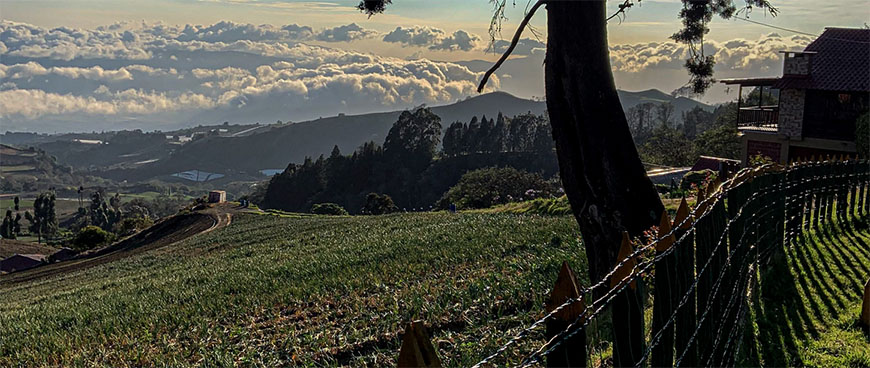
Cartago was once the capital of Costa Rica and is rich in historical and cultural heritage. Located in the central part of the country, it offers a cooler climate compared to the coastal towns. Expats are drawn to Cartago for its peaceful atmosphere, affordable living, and proximity to lush mountains and volcanic parks. The city is known for its well-preserved colonial architecture and vibrant local traditions. It’s a great option for those who appreciate a quieter lifestyle but still want access to good healthcare, educational iCartago Through My Eyes: A Female Expat’s Journey to Costa Rica’s Former Capital
Upon my arrival in Cartago, the former capital of Costa Rica, I was captivated by its serene atmosphere and rich tapestry of history and culture. Nestled in the central part of the country, Cartago offers a cooler climate compared to the coastal regions, making it a refreshing escape from the tropical heat. The city’s landscape, characterized by lush mountains and nearby volcanic parks, provides a daily reminder of Costa Rica’s breathtaking natural beauty.
Why Cartago Captured My Heart
Cartago is a haven for those who appreciate a quieter lifestyle while still enjoying access to modern conveniences such as excellent healthcare, educational institutions, and local markets. The city’s historical charm is evident in its well-preserved colonial architecture and the vibrant traditions that are celebrated with enthusiasm by the local community.
Living in Cartago, I’ve found a peaceful rhythm to life that contrasts significantly with the hustle and bustle of larger cities. The streets, lined with historical landmarks like the famed Basilica of Our Lady of the Angels, invite exploration and offer endless opportunities for cultural immersion.
A Day in the Life in Cartago
My typical day in Cartago begins with a stroll through the local market, where the friendly faces of vendors have become familiar over time. The market is a treasure trove of fresh produce and traditional crafts, reflecting the agricultural richness of the region. The temperate climate makes it a pleasure to explore the outdoors, whether I’m shopping for the week’s groceries or enjoying a leisurely walk through the city’s quaint streets.
The healthcare services in Cartago are commendable, with several well-equipped clinics and hospitals that ensure peace of mind for expats and locals alike. For families considering a move, the schools here offer diverse curricula that cater to both local and international students, making education a less daunting concern for expat parents.
Cost of Living: Affordable and Comfortable
One of the aspects of Cartago that initially attracted me was its affordability. Renting a comfortable home is surprisingly economical compared to costs in the U.S., Canada, or even other Costa Rican cities. A modest apartment can be rented for as low as $400 per month, while more spacious accommodations are available at still reasonable rates. This affordability extends to everyday expenses such as dining and transportation, allowing for a quality of life that is both high and sustainable.
Embracing Nature and Community
The proximity to natural wonders like the Irazú Volcano National Park is a privilege that I cherish deeply. Weekend excursions to the park and other nearby natural attractions provide a perfect blend of adventure and tranquility, allowing me and my fellow expats to connect with Costa Rica’s renowned biodiversity.
Integrating into the Cartago community has been facilitated by various cultural associations and social groups that are incredibly welcoming to newcomers. These groups offer language exchanges, cultural tours, and social events that have helped me forge strong connections within the community and enrich my understanding of Costa Rican culture.
Planning Your Own Adventure in Cartago
For anyone contemplating a move to Costa Rica, especially fellow women looking for a blend of adventure and tranquility, Cartago offers a perfect setting. It’s a city where history, culture, and natural beauty coalesce into a lifestyle that’s as enriching as it is serene. Dive into our detailed expat guide to Cartago to start planning your move to this charming city, and prepare to fall in love with its quiet charm and vibrant community spirit.
art planning your move to this charming and historic Costa Rican city.
San Jose – The Capital
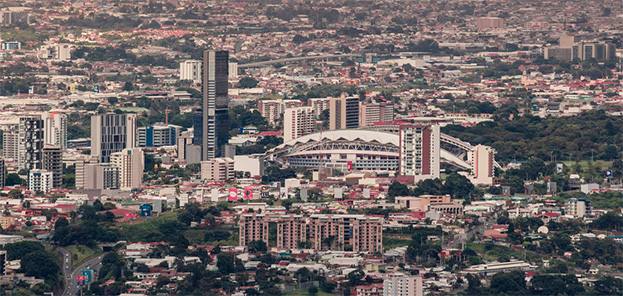
When I first arrived in San Jose from Canada. I wasn’t sure what to expect. Coming from Vancouver, an overpriced and dull city, I was eager to see how the capital of Costa Rica would hold up to my urban adventures—and San Jose did not disappoint. It’s a city teeming with culture, brimming with activities, and most importantly, offering vibrant expat enclaves that soon felt like home.
Why I Liked Living in San Jose
San Jose is a city where history meets modernity. The streets are lined with a mixture of colonial buildings and contemporary architecture, offering a visual treat and a hint of the city’s storied past. Museums, theaters, and galleries are abundant, making it a cultural hub ideal for anyone keen to dive deep into Costa Rica’s heritage.
The expat community here is not just active; it’s thriving. From cultural festivals to weekly meet-ups, there are endless opportunities to mingle and forge new friendships. This warm, welcoming atmosphere made it incredibly easy to settle in and feel connected.
A Day in the Life
My mornings in San Jose start with the sun—early rises are typical here, thanks to the city’s schedule and it’s proximity to the equator. Breakfast often includes a trip to the local ‘soda’, a traditional Costa Rican eatery, where I indulge in ‘gallo pinto’, a local staple of rice and beans, or a deliciously fresh ‘casado’, depending on my mood.
Navigating San Jose will be an adventure if you haven’t experienced it before. Initially, the lack of formal street addresses was daunting, but I’ve grown to love the challenge. It adds a layer of unpredictability and excitement to every outing. Public transport is readily available, and services like Uber have made it easier to explore the city safely and efficiently.
Weather Wonders and Woes
Okay, there’s no beach in San Jose, but there are near by steams and pools if you’re looking to take a dip. But, one of the most delightful surprises in San Jose has been the climate. Contrary to my initial fears of endless rain, I found that the weather here is quite pleasant. Mornings often greet me with sunshine, and the afternoon showers are a refreshing pause, cooling the city and making evenings serene and comfortable.
Living and Learning
As a female expat, safety for me is essential, and San Jose meets those needs. Furthermore, Learning Spanish has been part of the journey, enhancing my daily interactions and deepening my appreciation of the local culture. Markets like the Feria de Pavas have become my weekend staples, where I immerse myself in the local flavors and colors, and leave with the freshest produce I’ve ever tasted.
Cost of Living in San Jose
Living in San Jose is more affordable than many U.S. and especially Canadian cities. Housing options are plentiful, with something for every budget, from charming shared apartments in the historical districts to more modern setups in the suburbs like Escazu, which is popular among expats for its amenities and lifestyle quality.
Ending Thoughts
My time in San Jose has been transformative. The city has offered me a canvas to paint my adventures, a place to challenge myself, grow, and connect. For anyone considering a move, especially fellow women from abroad, San Jose is not just a place to live—it’s a place to thrive.
Making the Leap into Costa Rica:
Choosing the right place to call home in Costa Rica depends largely on your priorities. Whether you are drawn to the lively beaches of Coco and Jaco, the tranquil natural beauty of Quepos, the historical richness of Cartago and San Jose, Costa Rica offers a little bit of something for everyone. Due to this, Costa Rica has recently become a top choice for those looking to start a new chapter abroad. As you consider your options, please note that it is essential to plan ahead and perform your due diligence on your next destination. If you’d like a solid starting ground for preparing yourself to stay overseas for long periods of time, feel free to take a look at our emigration guides and tips too. Thank you for reading, and I hope to hear from you if you decide to move to Costa Rica!

Leave a Reply